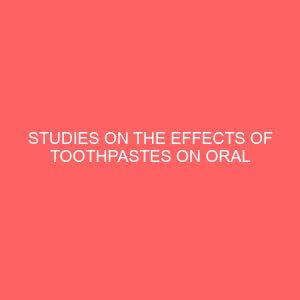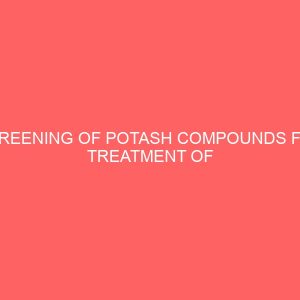Description
ABSTRACT
In order to ascertain the efficacy of some of commonly used toothpastes in Nigeria and to improve their antimicrobial qualities twenty three 23 toothpaste users were enrolled in the study Fifty 50 samples were collected of which 50 were mouth swabs and 50 were mouth washes Toothpaste TP C had the highest number of users and samples collected from users constituted 24 of the total samples Hundred isolates were obtained and characterized of which percentage of occurrence ranged from 22 of S aureus to 4 of C albicans pH of toothpastes was determined and the meanSTD pH of toothpastes ranged from 647007 of TP E to 770007 of TP B The MIC and MBC of antimicrobial agents on isolates was determined by broth dilution methods and ranged from 004mg/ml and 0625mg/ml of Ciprofloxacin to 375 and 50mg/ml of Erythromycin The KirbyBauer Disc diffusion method was used to determine antimicrobial activities of the toothpastes in vitro All toothpastes showed antimicrobial activity on isolates with mean zone of inhibition ranging from 1136mm E coli showed the highest sensitivity of 18 while C albicans showed lowest sensitivity of 132 to toothpastes TP A and TP F showed the highest effects on the isolates Crude extracts of C limon, C nucifera, A occidentale and D tripetla were obtained and screened in vitro for antimicrobial activities against isolates S mutans showed highest overall sensitivity of 229 to all the extracts A new toothpaste FennaPaste was formulated with common ingredients seen on toothpastes packs and also screened in vitro for antimicrobial activities against isolates There was significant difference in the activity of conventional toothpastes and newly formulated toothpaste pgt;005 when extracts obtained were added into the toothpastes Modifications of the extracts by heating and increasing of pH to 80 gave significant difference in activity pgt;005 Addition of these extracts in toothpaste is therefore suggested for improved antimicrobial effects
TABLE OF CONTENT
Title Page i
Certification ii
Dedication iii
Acknowledgement iv
Table of Contents v
List of Tables x
List of Figures xi
List of Plates xii
Abstract xiii
INTRODUCTION 1
General Objectives 5
Specific Objectives 5
LITERATURE REVIEW 7
History of Toothpastes 7
Classification of Toothpastes 8
Antidecay toothpaste 8
Desensitizing Toothpaste 9
Antiplaque toothpaste 9
Anticalculus toothpaste 9
Whitening toothpaste 10
Oral Organisms 14
Oral Health 14
Causes of Dental Caries 15
Epidemiology of Dental Carries 16
Gingivitis 18
Periodontitis 18
Oral Candidiasis 18
Epidemiology of Oral Candidiasis 19
Herbal medicine 19
Difference of Herbal and Conventional Drugs 20
Some Medicinal Plants and their Uses 22
Mode of Action of Antimicrobials 26
Antibiotic Resistance 28
Mechanism of Antibiotic Resistance 29
Lemon Citrus limon 30
Phytochemistry of Lemon 31
Cashew Anacardium occidentale 32
Phytochemistry of Anacardium Occidentale 34
Coconut 35
Dennettia Tripetala 35
Materials and Methods 37
Design of the Study 37
Specimens 37
Development of Questionnaire 38
Collections of Samples 38
Preparation of Culture Media 39
Isolation of Organisms 39
Subculture 39
Microscopy 39
Gram staining 39
Biochemical Tests 40
Coagulase test 40
Catalase test: 40
Citrate test 40
Triple Sugar Iron Agar TSI Agar 41
Indole Test 41
Methyl Red Test MR Test: 42
The Voges Proskauer test VP Test 42
Motility 42
Hydrogen Sulphide Production 43
Hydrogen Sulphide Production 43
Urease test 43
Test for sugar utilization 43
Microscopy for Yeast 44
Direct Mounts 44
Lactophenol Mount 44
Biochemical Tests for Yeast 44
Germ Tube Test 44
Determination of the Microbial Load of Different Brands of Toothpaste 45
Determination of pH of Toothpaste 45
Determination of Antimicrobial Sensitivity of Isolates 46
Antibiotic Stock Solutions: General Considerations 46
Preparation of Antibiotic Stock Solutions 46
Determination of Minimum Inhibitory Concentration MIC and Minimum
Bactericidal Concentration of MBC of Routine Antibiotics to Isolates 47
Preparation of the Inoculum 47
Broth tube Dilution Method 48
Reading Results 48
Determination of the Minimum Bactericidal Concentration MBC 48
Preparation of turbidity standard equivalent to 05 McFarland 49
Evaluation of the Antimicrobial Effects of Toothpastes 49
Preparation of paper discs: 50
Sensitivity Tests 50
Preparation of Cashew Leave Extract 51
Preparation of Lemon Citrus limon Extracts 51
Extraction of Lemon Juice 51
Extraction of Lemon Oil 52
Preparation of Pepper Fruit Dennettia tripetala extract 52
Preparation of Coconut Oil 52
Sterility Test 53
Preliminary screening of solvent for antimicrobial activity 53
Preliminary Screening of Extracts for Antimicrobial Activity 53
Sensitivity Test performance of Crude Extracts 54
Sensitivity testing of Combined Extract 54
Determination of MIC and MBC of Extracts 54
Determination of Antimicrobial effects of combination of toothpaste and extracts 54
Preparation of Toothpaste 55
Determination of pH of the newly formulated toothpaste 56
Determination of the sterility of Fennapaste 56
Determination of the antimicrobial Activity of FennaPaste F on Isolates 56
Determination of the effect of Individual extract with FennaPaste 56
Determination of the Effect of combined extracts with FennaPaste 57
Modification of Extracts 57
Determination of the Effects of modified extracts on isolates 57
Determination of the effects of active ingredients in toothpaste Sodium Flouride and Zinc Sulphate on Isolates 57
Statistical Data Analysis 58
Result 59
Discussion 85
Conclusion 89
Recommendation 90
References 91
Appendix A 100
Appendix B 101
Appendix C 102
Appendix D 103








Reviews
There are no reviews yet.